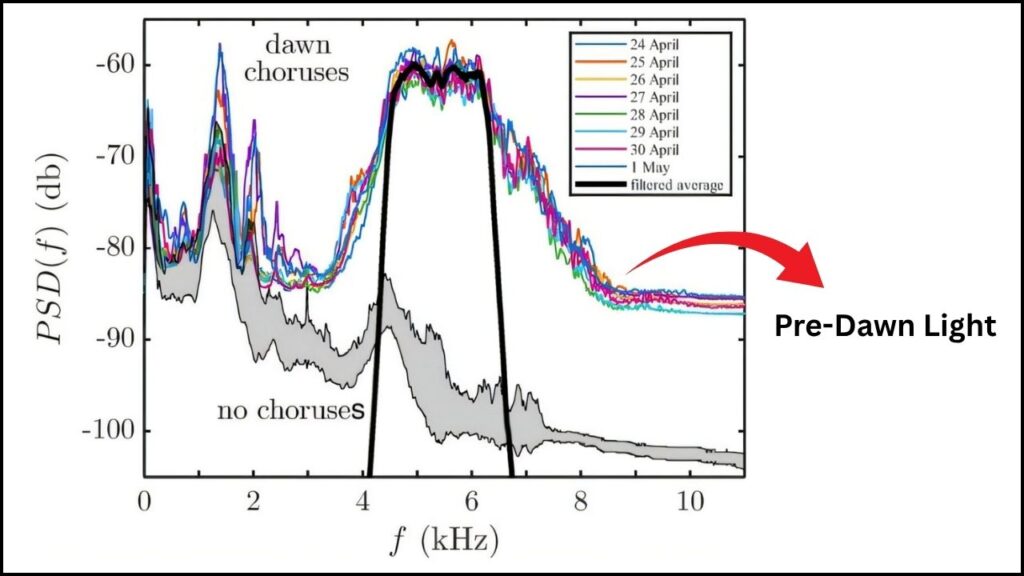Cicadas are well known for their loud, rhythmic singing that brightens many summer mornings. But did you know these insects can accurately tell time by measuring the early morning light? Recent groundbreaking research reveals that cicadas do not start their dawn chorus at random; instead, they sing precisely when the sun is 3.8 degrees below the horizon, during a phase called civil twilight. This very specific light level acts as a natural timer that triggers their collective singing.

This discovery comes from detailed field recordings near Bangalore, India, by an international team of scientists. It changes how we understand cicada behavior and shows how animals can use environmental cues like light intensity to make complex, synchronized group decisions. Combining biology, physics, and mathematics, the research offers insights valuable for ecologists, physicists, behavioral scientists, and nature lovers alike.
Table of Contents
How Insects Sync Songs with Pre-Dawn Light in a Wild Discovery
| Topic | Details |
|---|---|
| Target Species | Cicadas near Bangalore, India |
| Key Timing Cue | Sun 3.8° below horizon during civil twilight |
| Precision | Singing starts within ~60 seconds at a light threshold varying by just 25% |
| Light Intensity Trigger | Approximately 4–6 lux |
| Group Behavior | Cicadas respond to light and nearby cicadas’ singing |
| Research Methodology | Field recordings + physics models of phase transitions and group behavior |
| Research Teams | Scientists from India, UK (Cambridge University), and Israel |
| Study Published in | Physical Review E (2025) |
| Official Website for Reference | Physical Review E Journal |
Cicadas exhibit an extraordinary talent to tell time through pre-dawn light and coordinate their singing by collective decision-making. They fine-tune their chorus onset to a narrow range of civil twilight light intensity and amplify their song through social cues, producing one of nature’s most impressive synchronized performances. This finding highlights intricate connections between biology, physics, and environmental sensing, offering valuable lessons for scientists, naturalists, and educators.
How Cicadas Use Pre-Dawn Light to Tell Time
Animals often react to sunrise and seasonal light changes, but cicadas do something remarkable—they precisely synchronize their dawn chorus with a very narrow range of light intensity rather than a simple clock time.

- The cicadas start singing when the sun is exactly 3.8 degrees below the horizon, during civil twilight—the period before sunrise when there’s enough natural light to see clearly but the sun is still below the horizon.
- At this stage, the light intensity hits about 4 to 6 lux (lux is a unit measuring brightness, roughly comparable to indoor lighting).
- This threshold only varies about 25% during the crucial minutes, showing incredible photometric precision.
In other words, cicadas don’t just react to brightening skies. They have an internal biological system finely tuned to this specific light level to trigger their singing chorus.
The Science Behind the Synchrony — A Collective Decision
The cicadas’ chorus builds quickly, reaching peak volume within ~60 seconds after crossing the light threshold. This rapid and sharply synchronized onset puzzled scientists, prompting the question:
How do thousands of cicadas decide collectively and almost simultaneously to start singing?
The answer comes from a mathematical model inspired by physics—specifically, phase transitions seen in magnetic materials, where particles (or “spins”) align with an external magnetic field and with each other.
- Imagine each cicada as a “spin” that can be in one of two states: singing or silent.
- Each “spin” is influenced by:
- External light level, which acts like a magnetic field,
- Singing of nearby cicadas, which is the social or auditory cue.
- When the light cue triggers a few cicadas to sing, their sound encourages neighbors to join rapidly, like how an audience starts clapping after a signal.
- This social amplification combined with light sensitivity explains how the chorus starts sharply and in near-perfect unison.
This phenomenon is termed collective decision-making—a fascinating example of how local environmental signals and social interactions can generate large-scale natural synchronization.
Why This Discovery Matters
Understanding how cicadas measure time and synchronize their singing sheds light on several vital aspects:
- Ecological Benefits: Coordinated singing increases mating success by producing a louder, unified call that female cicadas detect more easily.
- Behavioral Insights: Shows how animals combine sensory inputs and social feedback to coordinate collective activity.
- Interdisciplinary Science: Demonstrates how physical models like phase transitions apply beyond materials to explain biological group behavior.
- Environmental Monitoring: Precise light-based timing in cicadas could help scientists study environmental changes or effects of artificial light pollution on wildlife.
Detailed Guide to the Study and Its Findings
1. Field Recordings in Natural Habitat
- The research team recorded cicada sounds over several weeks at two locations near Bangalore, India.
- They carefully synced audio data with ambient light measurements using sensors placed above the canopy.
- This setup allowed precise correlation between light intensity and cicada singing start times.
2. Data Analysis & Mathematical Modeling
- Using time-frequency analysis, researchers identified the exact moment when cicada singing rapidly increased.
- They introduced an “order parameter” quantifying the chorus volume, which showed a sharp S-shaped increase at the light threshold.
- Physics-inspired models, originally developed for magnetic spin alignment, were adapted to describe how cicadas react both to light and neighbors’ song activity.
3. Key Results
- The cicada chorus consistently began when the sun was 3.8 degrees below the horizon, regardless of minor daily changes in sunrise.
- The chorus buildup took about 60 seconds, showing remarkable temporal precision.
- The narrow light intensity window supports the idea that cicadas use a specific brightness cue rather than general dawn light.
- Social cues amplified responses to achieve tight synchronization for the enhanced group effect.
Practical Takeaways for Various Audiences
- Nature Enthusiasts: To hear the cicada dawn chorus, be outdoors during civil twilight, around 20-30 minutes before sunrise local time.
- Ecologists and Biologists: When studying insect behavior, measure both environmental cues like light and social signals among animals.
- Urban Planners: Consider how artificial lighting might disrupt natural animal behaviors sensitive to subtle light changes.
- Educators: Use cicadas to illustrate animal communication, environmental cue usage, and interdisciplinary links between physics and biology.
Scientists Finally Solve the Mystery of Lightning — This Theory Changes Everything
FAQs About How Insects Sync Songs with Pre-Dawn Light in a Wild Discovery
Q1: What is civil twilight?
Civil twilight is the period before sunrise or after sunset when the sun is up to 6 degrees below the horizon, providing enough natural light to perform most outdoor activities without artificial lighting.
Q2: How do cicadas hear each other?
Cicadas produce sound with organs called tymbals and can hear their neighbors through specialized auditory organs, enabling synchronized singing.
Q3: Does temperature affect cicada singing times?
Temperature plays a lesser role compared to light intensity in triggering the start of the cicadas’ dawn chorus.
Q4: Do all cicada species synchronize this way?
This precise synchronization has been observed specifically in cicadas near Bangalore; other species may rely on different cues or show less precise timing.
Q5: Why do cicadas coordinate their singing?
Coordinated singing magnifies the mating call, increasing chances of attracting females and reducing individual predation risk.



















